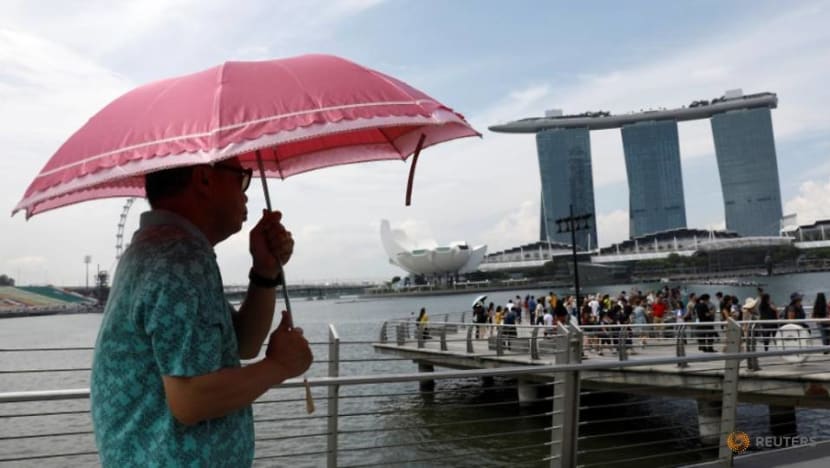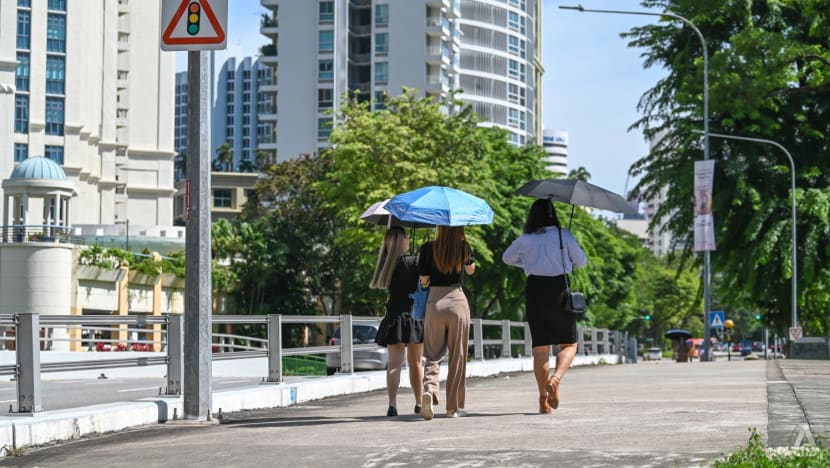CNA Explains: As temperatures hit record highs in Singapore and around the world, what can we do to beat the heat?
Singapore is warming up twice as fast as the rest of the globe, according to its Meteorological Service.


This audio is generated by an AI tool.
SINGAPORE: The year 2023 has been confirmed as the hottest in recorded history, a product of the double whammy of global warming and the El Nino effect.
In tropical Singapore, temperatures also hit a 40-year high back in May.
Just how hot is it now?
The global average temperature in November was 1.46 degrees Celsius warmer than pre-industrial levels - smashing the previous mark for the month and making it the sixth record-breaking month in a row, according to Europe's climate monitor.
Data from sources such as ice cores and tree rings have also suggested that 2023 could be the warmest in more than 100,000 years.
Previously, the hottest years on record were 2016 and 2020, when temperatures were an average of 1.25 degrees Celsius higher than pre-industrial times – or the years 1850 to 1900.
The record warmth this year is a result of climate change and the El Nino weather pattern, which warms ocean waters when it occurs typically every two to seven years.
Is it just me, or is Singapore especially scorching?
On May 13, the mercury hit 37 degrees Celsius in Singapore, equalling a 40-year record for the highest daily maximum temperature.
Singapore started recording temperatures in 1929.
The Meteorological Service Singapore said the high of May 13 was down to a combination of having few clouds, no rain and light winds, resulting in strong heating of land areas.
Singapore’s maximum daily temperature could reach 35 to 37 degrees Celsius by the year 2100, if carbon emissions continue to rise at the same rate, the Centre for Climate Research Singapore has projected.
The Climate Conversations: What's the impact of a hotter Singapore?

The island is warming up twice as fast as the rest of the world, at 0.25 degrees Celsius per decade, according to the Met Service.
“Similar to other cities, Singapore’s rising air temperature is caused by a combination of background global warming and local warming due to land use and land cover changes brought about by urbanisation, which results in the so-called urban heat island effect,” said Professor Matthias Roth from the National University of Singapore’s (NUS) geography department.
“The latter is significant and, as ongoing research shows, contributes about 1 degree Celsius, or half of the local air temperature increase observed in Singapore during the last roughly 50 years.”
The urban heat island effect is a phenomenon where urban areas, more built-up and densely populated, get warmer than rural areas.
This is due to waste heat emitted by the likes of cars and factories, along with considerable heat trapped by buildings during the day which dissipates at night.
What does the heat do to our minds and bodies?
Studies show a correlation between hot days and an increase in hospital visits for mood and anxiety disorders.
On a physical level, heat extremes have an impact on the human body, which has an average temperature of about 36.5 degrees Celsius. Anything beyond that, and we start sweating to help the body stay cool.
If that water loss is not replenished, we get dehydrated and our organs start to struggle with their essential tasks.
The heart is forced to pump harder as it tries to regulate the body's temperature.
Blood vessels thin as more blood is brought to the skin to aid in the sweating process, but this lowers blood pressure, leading to the risk of a heart attack.
Dehydration also decreases oxygen supply to the kidney, responsible for removing extra waste and extra fluid from the body. This can lead to chronic kidney disease.
Prolonged exposure to intense heat can also escalate to heat stroke, which is marked by an elevated body temperature, a rapid strong pulse and the loss of consciousness.
This can be fatal if the victim is not taken to a medical facility quickly.
Apart from heat, humidity is also an issue, and it gets dangerous when both are high.
“Singapore has a highly humid climate. This means when it is hot, it is also hard for sweat to evaporate. This greatly reduces thermal comfort and increases the risk of heat illness because the body cannot cool down easily,” said Dr Koh Tieh Yong, co-chair of the working group for Asian-Australian Monsoon in the World Climate Research Programme.
Scientists measure temperature and relative humidity with what is called "wet bulb temperature", which is the level at which water stops evaporating from a wet thermometer bulb, meaning it can no longer cool as the atmosphere is fully saturated with water.
Studies show that humans can no longer cool themselves down when the wet bulb temperature hits 35 degrees Celsius.
That can lead to heat exhaustion, with intense thirst, dizziness or fainting, a rapid weak pulse and cold clammy skin among the signs.

Those most at risk of heat-related illnesses are old people or those with underlying conditions such as heart disease, as they are less able to cope with the strain heat places on the body.
In Singapore, heat stress risk is highest in the Central Region, where dense urban development overlaps with large populations of elderly people, NUS researchers have found.
The Lancet science journal reported that heat-related deaths in people aged over 65 increased by 85 per cent in the period from 2013 to 2022, compared to between 1991 and 2000.
Young children are also vulnerable, as they are more likely to become dehydrated because they lose fluid more quickly.
Those who work under the hot sun, such as agriculture and construction workers, are also at risk.
How is Singapore battling the heat?
Climate scientist Dr Koh noted that a few new towns across Singapore, like Tengah in the west and Punggol in the north-east, are designed with “wind corridors” for better urban ventilation.
“The ratio of green and blue spaces, vis-à-vis parks and water bodies, is higher to mitigate the urban heat island effect. This is because evaporation of water from plants and water surfaces helps to keep surface temperature lower,” he said.
On an individual level, Singapore in July launched a Heat Stress Advisory to help people gauge heat-related risks while outdoors.
The three levels in the advisory – low, moderate and high – are based on the Wet Bulb Globe Temperature (WBGT), an internationally recognised indicator that reflects the main environmental factors contributing to heat stress.
The advisory also gives tips on how to adjust activities, take protective action and dress appropriately at each level.
Amid scorching temperatures in Singapore, several schools in Singapore have also eased rules on uniforms, letting students dress in physical education attire or school T-shirts.
Schools also minimise outdoor physical activities between 10.30am and 3.30pm, when temperatures are generally higher.
The groups that safeguard Singapore’s security have also adjusted training and operation processes with the heat in mind.
In the Singapore Armed Forces (SAF), commanders are given leeway to modify attire and load for strenuous activities.
The SAF also opened a new Heat Resilience and Performance Centre in January, to address long-term challenges of maintaining human performance amid rising global temperatures.
The SAF, the Singapore Police Force and the Singapore Civil Defence Force have all redesigned their uniforms to be cooler, lighter, more breathable or better able to absorb moisture.
Civil defence officers also undergo heat acclimatisation training as part of their academy syllabus, before serving on the frontlines.

What else can Singapore do?
Singapore risks worsening heat levels when it clears forested areas for housing and industrial development.
High-rise buildings can push temperatures by up to 4.3 degrees Celsius compared to undeveloped land, according to a NUS study published in 2022.
It also found the warming effect to be milder - around 2.5 degrees Celsius - for residential areas with more vegetation.
“While mitigating the anthropogenic global warming effect caused by rising greenhouse gases in the atmosphere is beyond the reach of an individual country or city, the local warming contributions can be mitigated through climate-sensitive urban planning and building design,” said Prof Roth from NUS.
It's important to preserve green spaces such as forests, parks and roadsides where trees grow, as they provide shade and reduce daytime heating, he added.
“Other interventions include preservation of open spaces to allow night-time cooling, creation of wind corridors which can provide natural cooling, or the application of surface paints on roads and buildings which during the day efficiently reflect incoming energy from the sun back into space,” said Prof Roth.
People can also play their part by taking public transport to get around. With fewer cars on the road and smoother traffic conditions, less man-made heat is emitted.
In indoor settings, Singapore ultimately relies on air-conditioning to keep environments pleasant and to enhance workplace productivity, said Dr Koh.
“Thus, we are limited by cooling technologies. Innovative designs are needed to cool air at high thermodynamic efficiency, so that as little waste heat is produced as possible,” he added.
In affluent Singapore, the increasingly widespread use of air-conditioning is inevitable.
But an overreliance on artificial cooling would beg the question of how well Singapore and Singaporeans can eventually adapt to a hotter new normal, said Dr Koh.
“For example, having grown up being accustomed to cooler indoor environments, would our national servicemen be able to function as well as before in the natural outdoors?" he asked.
"In commercial hubs, would the lack of cooling due to power outage be as incapacitating as a water supply cut-off?"
Additional reporting by Samuel Ng



















